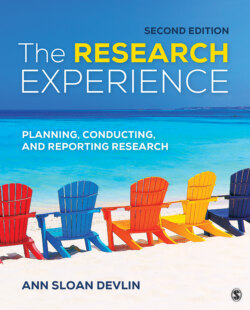Читать книгу The Research Experience - Ann Sloan Devlin - Страница 111
Descriptions of Images and Figures
ОглавлениеBack to Figure
The types of research designs, and the categories of research approaches, represented by numbers, are as follows.
Research designs:
Correlational (1, 2, and 4)Correlational (1): Sample as a wholeCorrelational (2): Group DifferencesCorrelational (4): Cross-sectional (group differences with developmental focus)
True experiments (3)
Back to Figure
Text reads, “Abstract. The Stereotype Content Model proposes that competence (or alternatively, agency) is a fundamental dimension of stereotypes. According to this model, beliefs about agency are partially due to the status relations between groups, such that high status groups are perceived to possess agency, whereas low status groups are perceived to lack agentic characteristics. Despite the considerable support for this model, the psychological processes that produce these stereotypes have not been fully explored. In the current studies, we examined whether the correspondence bias may be partially responsible for the stereotype that members of low status groups lack agentic characteristics, relative to those who belong to high status groups. Across both studies, a measure of the correspondence bias predicted such stereotypical beliefs, even after accounting for variables that are known to be associated with beliefs about high and low status groups. This effect was observed when beliefs about the status of groups were experimentally manipulated, and when we measured stereotypical beliefs about two sets of actual high and low status groups.” The four keywords listed at the bottom are attribution, correspondence bias, stereotype content model, and stereotypes.
Back to Figure
The screenshot shows three sections.
The first section shows an entry field, with the entry environmental psychology, followed by the Browse button. There are three radio buttons under the entry field: Term begins with, term contains, and relevancy ranked. The entry is browsed in PsycINFO—Thesaurus.
The second section shows two hyperlinked options for Page: Previous and Next. Previous is grayed out.
Text reads, “Select term, then add to search using:” The text is followed by an entry field, with entry OR, and up-down buttons. A button, labeled Add, is next to the field.
The third section lists subject terms, each preceded by a checkbox. Text before the list reads, “(Check term to display details.)” The subject terms are as follows: Environmental Psychology, Ecological Psychology, Environmental Adaptation, Noise Effects, Environmental Planning, Psychological Terminology, Environmental Stress, Environmental Policy, Environmental Enrichment, Environmental Effects, Environmental Education, Environmental Attitudes, Psychology of Women, and Jungian Psychology.
Back to Figure
The horizontal axis is labeled year, ranging from 1855 to 2020 in increments of 15. The vertical axis is labeled documents, ranging from 0 to 40 in increments of 10. All data are approximate. The number of documents is 0 till 1940, fluctuates between 0 and 1 till 1960, increases to more than 40 documents till 2019 with sharp fluctuations, and decreases to 14 documents in 2020. There is a point at (1972, 7), labeled “1972. 7 Documents in Scopus. Click point to view document list.”
Back to Figure
The screenshot shows two icons: A magnifying glass over a sheet of paper, and a folder with plus icon. The result shows an academic journal. Text reads, “3. Urban design aesthetics: The evaluative qualities of building exteriors. Nasar, Jack L.; Environment and Behavior, Vol 26(3), May, 1994 Special Issue: Design review: Public participation in the evaluation of design. pp. 371–401. Publisher: Sage Publications; [Journal Article]. Subjects: Aesthetic Preferences; Architecture; Emotional Responses; Evaluation; Urban Planning. Times Cited in this Database: (35).” The hyperlinked option at the bottom of the text is labeled, Check for Full Text.
Back to Figure
The screenshot shows two icons: A magnifying glass over a sheet of paper, and a folder with plus icon. The result shows an academic journal. Text reads, “1. Impressions of psychotherapists’ offices. Nasar, Jack L.; Devlin, Ann Sloan; Journal of Counseling Psychology, Vol 58(3), Jul, 2011 pp. 310–320. Publisher: American Psychological Association; [Journal Article]. Subjects: Aesthetic Preferences; Aesthetics; Personalization; Psychotherapists; Therapeutic Environment; Adulthood (18 yrs & older); Male; Female. Cited References: (61) Times Cited in This Database: (6).” The two hyperlinked options are labeled, HTML Full Text and PDF Full Text.
Back to Figure
There are two hyperlinked options: Refine or alter criteria on the top right corner, and Submit a request on the bottom left corner. Text reads, “Search criteria: Fisher, Bonnie (05/01/1955). ‘Fear spots in relation to microlevel physical cues: Exploring the overlooked.’. The journal of research in crime and delinquency (0022-4278), 32 (2), p.214. Citation: Email or Export/Save. Sorry, no holdings were found for this journal. Please see additional options below for finding this journal. Additional options: Interlibrary Loan.”
Back to Figure
In your initial research idea, variable 1 is the satisfaction with athletic participation, which consists of many alternative variables, before reaching variable 2, which is college achievement.
The research gap is closed when the relationship with coach is considered as variable 1, which consists of fewer alternative variables, before reaching variable 2, which is college achievement.
